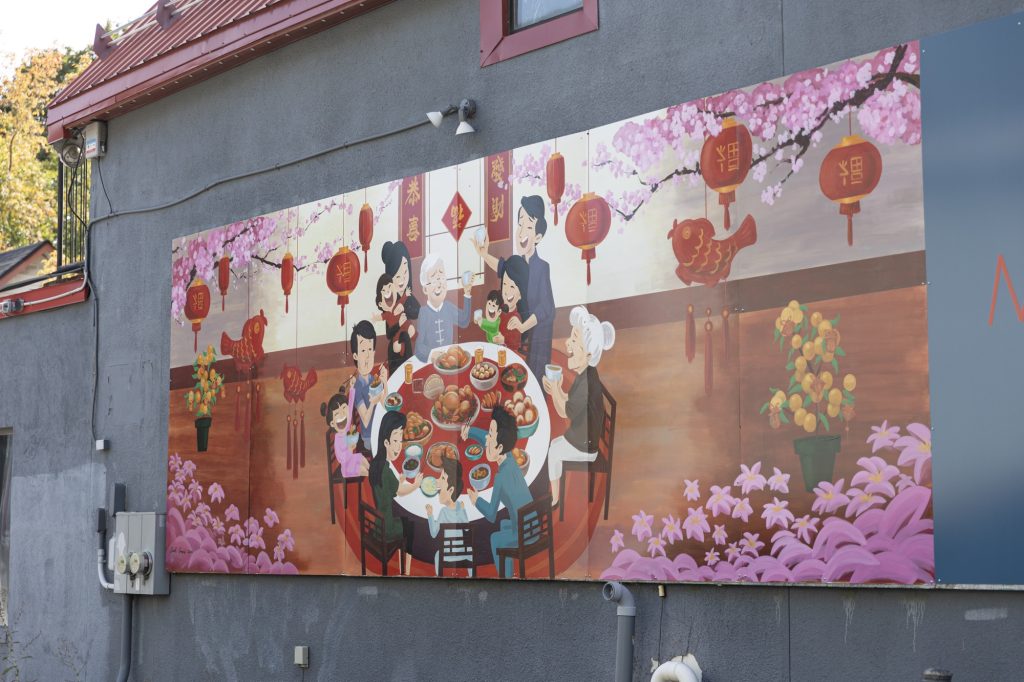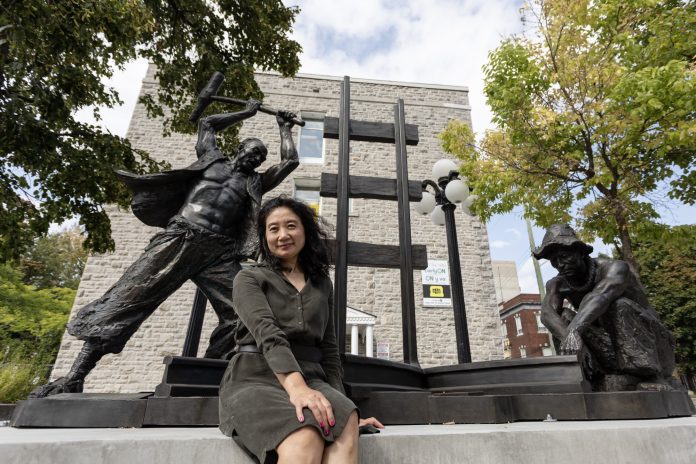If you’ve taken a walk, drive or bike through Chinatown at any point this summer, you’ve probably noticed a new, striking historical sculpture depicting an essential yet often understated part of Canada’s history.
It’s purposefully hard to ignore.
The bronze in front of 755 Somerset Street W includes two men on either side of a railroad perched on top of a map of Canada, which forms the base of the piece. The shirtless man on the right, symbolizing suffering, is squatting, exhausted during a rare break from his tireless work. Opposite him is another man, symbolizing strength, frozen mid-swing with a sledgehammer as he targets the railway between them. The rail trails back, away from the street, before curving upwards to the artwork’s tallest height of 3.4 metres.
According to the artist behind the work, Yi Chang, the skyward rail serves as an abstract memorial to the 17,000 Chinese workers who risked or lost their lives building the Pacific Railway between 1880 and 1885. Chang and her sister, Shi, completed the sculpture over the span of three months.
Importantly, the shape of the railway forms the Chinese character “人” meaning human.
“We want to say, humans, if we work together, we can win anything, we can build a history, we can do everything,” Chang said.
Erected in June 2025, the same year as the 140th anniversary of the railway’s completion, it’s a testament to an account long left out of textbooks. The sculpture honours those Chinese workers who braved systemic discrimination and treacherous working conditions to complete a railway which reshaped Canada’s history.

“They were paid less than other people and they did the hard jobs,” Chang said of the Chinese workers who built the railway. “A lot of people lost their lives.”
“To tell you the truth, when we did the research for that part of history, I couldn’t find much at all because I don’t think Western people want to know that.”
Chang said research was essential to ensure accuracies like the figures’ clothing and their regional backgrounds in China.
“This is part of history,” Chang said. “We have to make sure everything is correct.”
The project is one of several works Chang has contributed throughout Chinatown. Using her art, Chang consistently looks to strengthen the influence of Chinese culture, history and tradition in its own right, but also within the Canadian zeitgeist.
“A lot of people don’t remember what Chinese people did,” Chang said. “So that’s why we want to show this is where Chinese people are a part of Canadian history.”
Chang was born in Changchun in northeastern China within a family of artists. When she was 10 years old, her family moved to Tokyo, Japan to follow the art career of her father, Jue Yuan Chang. In time for high school, her family moved again to Canada. Along with her sister, Chang attended the Ontario College of Art in Toronto before the sisters went to Sheridan College in Hamilton to learn animation. It was there, in her classes, where she met her now husband, Christopher Richard, eventually adding yet another artist to the family.
The program at Sheridan also led both Chang and her sister to a career in animation, notably working in the animation department for Wild Kratts on PBS Kids.
But Chang’s multifaceted approach to art couldn’t limit her to a career in animation. In 2011, she opened an art gallery in Chinatown with her mother, Hang Hu, named Art Flow Gallery. She said her motivation for starting her own gallery was the general lack of Chinese art and artists in Canadian galleries.

While her gallery closed during the COVID-19 pandemic, Chang remains heavily involved in Chinatown’s community today, painting murals and even organizing parade performances during the neighbourhood’s famous annual night market.
One of Chang’s murals is bolted to the side of the popular Mai Mai 2 Beauty Salon. It’s a tall mural showing a traditional Chinese landscape, completed in 2024.
Chang said she made use of strong blues and visible brush strokes to emphasize a traditional Chinese painting style. Importantly, she said the fisherman in the forefront of the mural was intentionally faced toward the business to direct prosperity into the salon. That’s because fish symbolize abundance or good fortune in Chinese culture.
Further West down Somerset Street, Chang’s next work, this time in collaboration with her husband, is on the wall of Mekong, a family restaurant serving Chinese cuisine.
Chang’s longtime friend and owner of Mekong, Winnie Zhang, was looking for a mural to depict a multigenerational Chinese family dinner to match the feel of her own restaurant. So the couple chose to paint a Chinese New Year’s Eve dinner, showing plenty of traditional Chinese imagery and, of course, including lots of fish.
According to Zhang, the mural was exactly what she asked for.
“I love these pictures,” Zhang said. “You can tell it’s generation to generation. It’s full of love and full of happiness.”
Since losing her Somerset Street art gallery in the pandemic, Chang has helped turn the Chinatown neighbourhood into a gallery of its own by bringing her works to the street. Still, she hopes one day she can find a new location to reopen her gallery to spotlight Chinese art and culture.
Today, on a street covered by murals, Chang’s paintings and her new sculpture add to a street beautification effort in a Chinatown working hard to keep its cultural identity alive.
For Chang and her family of artists, that cultural identity is ultimately at the heart of everything she creates.
“I just wish I can use my art skills to do more things for the community, for Chinatown, for more people and just try to show more Chinese culture to this country.”
“I think I’m doing it,” Chang laughed.
